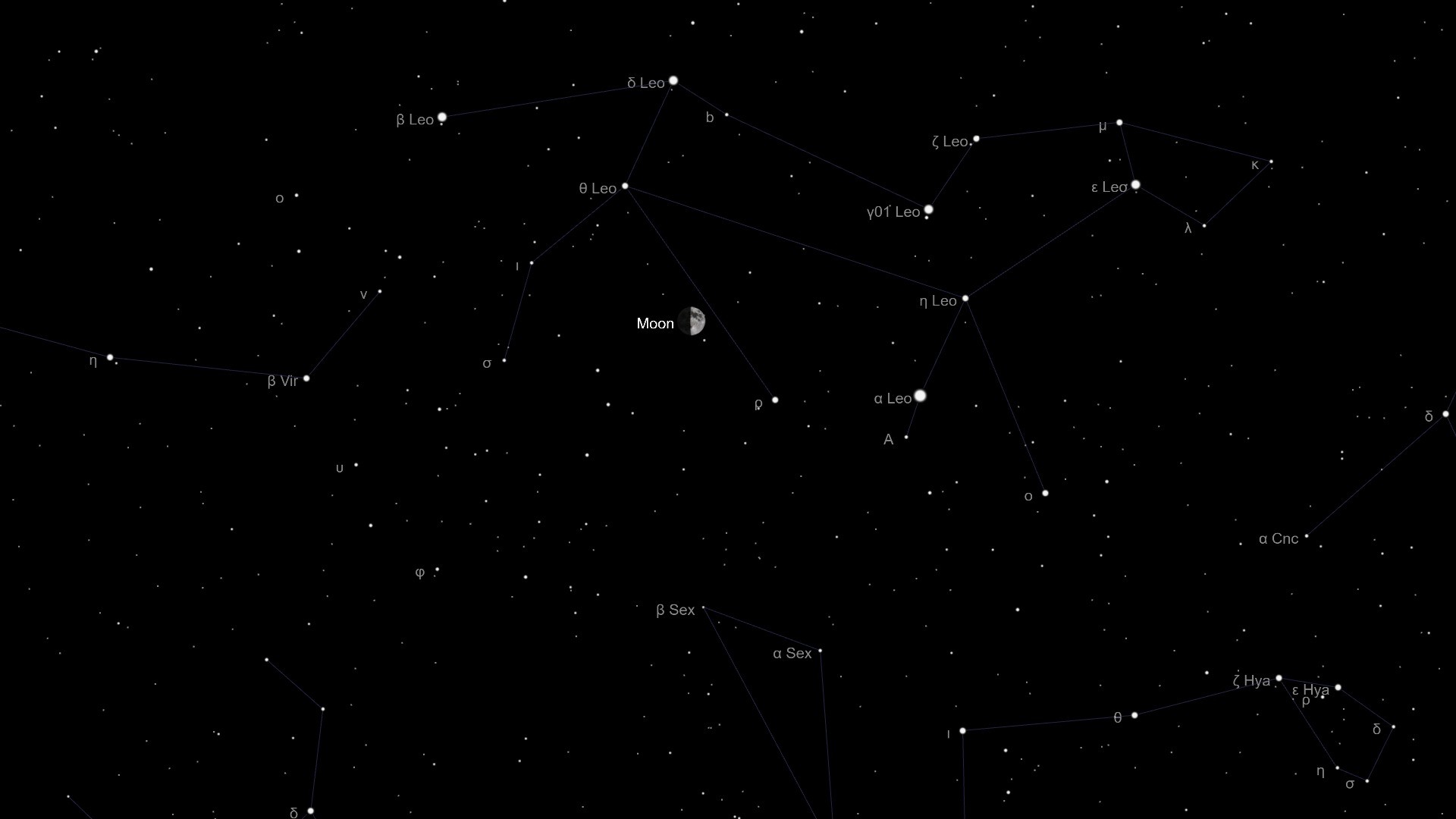Watch the half moon of May shine by Leo the Lion in the night sky tonight
The lunar face will be half-lit by the light of the sun tonight during a phase called the first quarter moon.

The moon will reach its first quarter phase on Saturday (May 27), meaning the lunar face will be half-illuminated by the light of the sun.
The fact that the moon will be half-illuminated during this phase of its 29.5-day lunar cycle may make the name "first quarter" moon somewhat confusing. Its name actually refers to the fact that this phase falls exactly a quarter of the way through the lunar cycle.
According to In the Sky, skywatchers in New York City will be able to see the first quarter moon shortly after it rises at 12:21 p.m. EDT (1626 GMT) until just before its sets, sinking below the horizon at around 2:02 a.m. EDT (0602 GMT).
Related: What is the moon phase today? Lunar phases 2023

Want to get a good look at the first quarter moon in the night sky? We recommend the Celestron Astro Fi 102as the top pick in our best beginner's telescope guide.
The half moon will serve as an excellent guide tonight to help skywatchers locate and identify the Leo constellation, the Lion. From New York City, the moon and Leo will be fairly high in the southwestern sky at sunset.
The moon will be located just under "the Lion's" back legs, between its feet. Once you've located the moon and Leo, you can see the lion appearing to gaze westward towards a bright Venus and red Mars near the twins of Gemini.

The first quarter moon phase occurs halfway between the beginning of the lunar cycle, the new moon — at which time the lunar face is completely dark — and the full moon, at which point it is completely illuminated. This means the half-lit nature of the lunar face at this stage makes complete sense.
Get the Space.com Newsletter
Breaking space news, the latest updates on rocket launches, skywatching events and more!
Since the last new moon, which occurred on Friday, May 19, the illuminated proportion of the lunar face has been growing, a process that astronomers refer to as waxing. Following the first quarter moon, the waxing of the moon will continue until it is completely illuminated during the next full moon, the Strawberry Moon, on June 4.
After this, the process that has led to the full moon will reverse, and the moon will be said to be waning. Light will then begin to recede across the lunar face, giving way to shadow as the lunar cycle heads to the next new moon. When the lunar face is once again half illuminated, it will be in a phase called the third quarter moon, which is, in many ways, the mirror image of the first quarter moon. Observers based in the same location during the first and third quarter moons will see opposite sides of the moon illuminated, but which side of the moon this depends on which hemisphere a skywatcher is located in.
These aren't the only changes that the moon will undergo as it heads from the new moon to the full moon and then back again, however. In the build-up to the first quarter moon, the moon has been rising and setting an hour later each night. So while the new moon rose and set with the sun, and was mostly absent from the night sky, the first quarter moon will be visible until around midnight.
This will continue until the full moon, which will rise when the sun sets and set when the sun rises, making it visible through the night. The moon will continue to set an hour later each night, and as a result, this means that the third quarter moon mirrors the first quarter moon in another way.
Whereas the first quarter moon rises around midday and sets around midnight, the third quarter moon, which next occurs on June 10, rises at around midnight and then sets at around midday.
If you are hoping to catch a look at the moon during its first quarter phase or any other time, our guides to the best telescopes and best binoculars are a great place to start.
If you're looking to snap photos of the night sky in general, check out our guide on how to photograph the moon, as well as our best cameras for astrophotography and best lenses for astrophotography.
Join our Space Forums to keep talking space on the latest missions, night sky and more! And if you have a news tip, correction or comment, let us know at: community@space.com.

Robert Lea is a science journalist in the U.K. whose articles have been published in Physics World, New Scientist, Astronomy Magazine, All About Space, Newsweek and ZME Science. He also writes about science communication for Elsevier and the European Journal of Physics. Rob holds a bachelor of science degree in physics and astronomy from the U.K.’s Open University. Follow him on Twitter @sciencef1rst.









